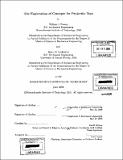| dc.contributor.advisor | David Wallace. | en_US |
| dc.contributor.author | Kudrowitz, Barry M | en_US |
| dc.contributor.author | Fienup, William James, 1980- | en_US |
| dc.contributor.other | Massachusetts Institute of Technology. Dept. of Mechanical Engineering. | en_US |
| dc.date.accessioned | 2009-10-06T14:59:48Z | |
| dc.date.available | 2009-10-06T14:59:48Z | |
| dc.date.copyright | 2005 | en_US |
| dc.date.issued | 2006 | en_US |
| dc.date.issued | 2005 | en_US |
| dc.identifier.uri | http://hdl.handle.net/1721.1/49333 | |
| dc.description | Includes bibliographical references (p. 199-200). | en_US |
| dc.description | Thesis (S.M.)--Massachusetts Institute of Technology, Dept. of Mechanical Engineering, September 2005 (first author); and, (S.M.)--Massachusetts Institute of Technology, Dept. of Mechanical Engineering, June 2006 (second author). | en_US |
| dc.description.abstract | (cont.) The second concept, eDarts, involved incorporating a capacitor powered micro-circuit and LED into foam darts similar to those used in the current line of Nerf® products. The eDarts created a tracer shot or laser bullet" effect when used in low light conditions. Safety, projectile mass, and axially symmetric loading were the greatest issues of concern. The final suggested eDart incorporated a standard DC power connection with a simple mechanical switch. The eDarts reached comparable distances to the current foam darts on the market. while maintaining a safe Kinetic Energy Density. | en_US |
| dc.description.abstract | The goal of this research has been to develop new concepts for foam projectile toys. The team followed a standard design practice and brought two unique concepts to an alpha-prototype level. Through brainstorming sessions the team generated over 100 concepts of which the sponsor selected twelve high potential concepts for first order prototyping. Of these prototypes, the team chose two concepts worthy of refinement and further development. The operational principles of the highest potential concepts were thoroughly analyzed and developed through a series of prototypes. The first concept, Hopper Popper Activation, involved using a bi-stable rubber spring to propel foam balls. This concept created a simple, space-saving, and effective means of storing energy. The hopper popper was implemented in several devices, the most successful being a small hand held toy called the Hand Popper. The greatest issue of concern with the Hopper Popper Activated concepts was the force required to load the toy. The final design implemented a low friction system with a ball guiding channel to reduce this loading force. The final design required a lower operational force than the comparable product on the market, while capable of propelling foam balls 20% further. | en_US |
| dc.description.statementofresponsibility | by William J. Fienup and Barry M. Kudrowitz. | en_US |
| dc.format.extent | 200 p. | en_US |
| dc.language.iso | eng | en_US |
| dc.publisher | Massachusetts Institute of Technology | en_US |
| dc.rights | M.I.T. theses are protected by
copyright. They may be viewed from this source for any purpose, but
reproduction or distribution in any format is prohibited without written
permission. See provided URL for inquiries about permission. | en_US |
| dc.rights.uri | http://dspace.mit.edu/handle/1721.1/7582 | en_US |
| dc.subject | Mechanical Engineering. | en_US |
| dc.title | The exploration of concepts for projectile toys | en_US |
| dc.type | Thesis | en_US |
| dc.description.degree | second author | en_US |
| dc.description.degree | S.M. | en_US |
| dc.contributor.department | Massachusetts Institute of Technology. Department of Mechanical Engineering | |
| dc.identifier.oclc | 86111240 | en_US |
